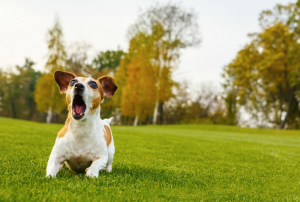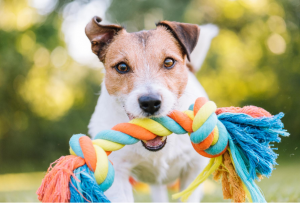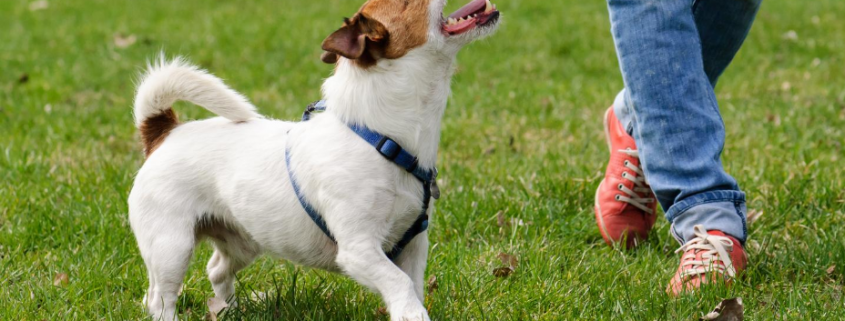Ask Crystal: A Bark Bigger Than His Bite
Welcome to “Ask Crystal,” where you can ask your pet behavior questions! You can submit your question for Crystal at the bottom of the page!

Dear Crystal,
I have a 4-year-old Jack Russell we rescued him from the kennels in March. He’s good as gold except he seems a little nervous and when he gets nervous, he’ll start to wee. But the main problem and what’s really difficult is his behavior around other dogs. When he’s on the lead he can spot a dog from miles away and straight away he starts lowering his body almost crawling along the floor never taking his eyes off the other dog, until he gets close enough then he’ll start barking liking a crazy dog and won’t stop until the other dog is out of sight and even then he’s still looking back and barking at it as if he is telling them off. When he is off the lead, if he sees a dog, he’ll run up to it, sniff the other dog, then he’ll bark at it and run off then go back again and bark at the dog, then run off again and he’ll repeat this until I put him back one the lead. He’s never bitten another dog but he’s so aggressive when on the lead and constantly barking at other dogs. It’s now becoming a chore to take him for a walk. I bought him for my daughter and he’s brilliant with her but now I’m having to leave him in the house when I take my daughter anywhere because it’s just too stressful. I had a heart attack a few months ago so would really love a nice peaceful walk……please help.
Sincerely,
Frightened Fido
Dear Frightened,
Trust me when I say I can sympathize with this scenario. I have had pretty much only reactive dogs for years. It is becoming more and more common these days that dogs will develop some sort of reactivity. We expect dogs to be okay with a lot of things that aren’t necessarily natural for them. Reactivity is basically an overreaction to a stimulus. The stimulus can be anything really. Common things that dogs are reactive to are other dogs, cats, cars and people.
Reactivity normally manifests as a dog that barks, lunges, growls, basically makes an aggressive display when they see the stimulus from a particular distance. The distance will vary from dog to dog and changes throughout the dog’s life. This distance is referred to as the dog’s threshold. This is the distance at which the dog goes into the overreaction.
The cause of reactivity can be a fear of other dogs or frustration at not being able to get to the other dog. They may want to play with the other dog but it can appear as aggressive behavior. Sometimes it starts out as one motivation and turns into another later. The behavior continues because the if the dog is afraid, they think their behavior made the other dog go away. If they are frustrated, it will continue as they continue to get more and more frustrated. Barking and excitement releases endorphins which feel good so that plays a role in why the behavior continues as well.
Many reactive dogs are not aggressive or reactive when they are not behind a barrier or on a leash. I have seen some pretty scary looking behavior behind a fence but once the dog is loose with the other dog, they are fantastic. Based on how he behaves off leash, I would say your dog may have fear of other dogs in general, not just related to a leash. It also sounds like he could be conflicted about his feelings. It’s hard to say without seeing it. It sounds like the leash behavior is your biggest challenge here so I will try to address that. I suggest that you do not bring him to play with other dogs at this point without the supervision of a professional behaviorist or trainer. Dogs do not get better by exposure alone and he very likely could get worse if he feels threatened.
Our first goal is to figure out how to reduce your dog’s stressors. Every time he experiences stress, his body is flooded with stress hormones like cortisol and adrenaline which take time to dissipate. Every subsequent stressor builds on the previous stressor. We refer to this as trigger stacking. As the stress stacks up, the dog becomes reactive more quickly and the reactions can be more severe.
Start by making a list of potential stressors and how you could reduce them. For example, if the dog likes to sit in front of a window and bark at other dogs, keep the dog out of that room or close the shades. If your dog sees a lot of other dogs on walks, there are a couple things to consider. Depending on the neighborhood, you may find that there are times of day that are more busy than others. Try to pick a quiet time and a route that allows you to get off the road and go down other paths if another dog is coming. You may also want to consider walking somewhere other dogs are less likely to be. Most reactive dog owners have their secret spots they like to walk. Schools on the weekends are usually a good bet.
 My other suggestion is that you find other ways to exercise him that do not involve walks. I feel like it has been beaten into us that we must walk our dogs to exercise them and to be good dog owners. While I do see the value in certain types of walks like decompression walks, in the case of a reactive dog, a park or neighborhood walk may do a lot more harm than good at this point. Multiple exercise sessions throughout the day have more value than one neighborhood walk. This type of dog usually likes to fetch and I bet you could teach him how to use the flirt pole considering he likely has an innate need to chase. Tug can also be a great way to burn energy.
My other suggestion is that you find other ways to exercise him that do not involve walks. I feel like it has been beaten into us that we must walk our dogs to exercise them and to be good dog owners. While I do see the value in certain types of walks like decompression walks, in the case of a reactive dog, a park or neighborhood walk may do a lot more harm than good at this point. Multiple exercise sessions throughout the day have more value than one neighborhood walk. This type of dog usually likes to fetch and I bet you could teach him how to use the flirt pole considering he likely has an innate need to chase. Tug can also be a great way to burn energy.
The other way to stimulate a dog is through mental stimulation like training, enrichment and scent work. Jack Russells are hunting dogs so I wonder if he might get really into finding hidden food around the house or yard. Some people hide food on boxes for the dog to search. I would make him work for every bite of food. You can use it for training, put it in an enrichment toy, scatter it in the yard or hide it around the house to name a few. These dogs are burrowers so maybe build a sand pit in a kiddie pool and hide treats and toys in it for him to sniff out daily. Find ways to work on training exercises at least 10-15 minutes a day.
 Some training that you could get started on now would be attention games and some distraction games. This way eventually if you are walking him and another dog comes into view, you can try to get his attention on you and distract him. I like Auto Check In which teaches the dog to automatically check in periodically. Eye contact games like Up Down and Ping Pong from Leslie McDevitt’s Pattern games teach dogs that eye contact is fun and will encourage them to check in more as well. Watch Me is a way to teach a verbal cue for your dog to make eye contact. The Name Game teaches the dog to come back to you and look at you when you call his name. Find It teaches dogs to sniff the ground when you tell them to as a great way to distract them while the trigger passes. Check the website this week for my video on how to introduce distractions into training and then the following week for my Attention Games video that will demonstrate most of these games.
Some training that you could get started on now would be attention games and some distraction games. This way eventually if you are walking him and another dog comes into view, you can try to get his attention on you and distract him. I like Auto Check In which teaches the dog to automatically check in periodically. Eye contact games like Up Down and Ping Pong from Leslie McDevitt’s Pattern games teach dogs that eye contact is fun and will encourage them to check in more as well. Watch Me is a way to teach a verbal cue for your dog to make eye contact. The Name Game teaches the dog to come back to you and look at you when you call his name. Find It teaches dogs to sniff the ground when you tell them to as a great way to distract them while the trigger passes. Check the website this week for my video on how to introduce distractions into training and then the following week for my Attention Games video that will demonstrate most of these games.
Routine is also really important for dogs that are anxious and/or fearful. If the dog knows what comes next everyday it can really help them to relax. Make a schedule for your dog of enrichment, training, exercise, naps and family time and try to keep to the same schedule as much as possible.
Many people don’t really have the time to work on the training to desensitize and counter condition reactivity and fear of other dogs. It can be complicated and time consuming. The general concept of the training is to keep the dog subthreshold and give it reinforcers like food when it looks at the trigger without reacting. The idea is to create a positive association of food with the appearance of the other dog which changes their emotion about the trigger. Slowly as the training begins working, we can decrease the distance and add in other factors. It is obviously more complicated than that but that is in a nutshell version.
You must first be able to manage the dog’s environment by avoiding his triggers, reducing his stressors and finding alternative ways to exercise and stimulate him. Only then can a training plan be put into place. It will not work if the dog continues to experience exposure to triggers that is not under threshold and within a training exercise. Once you have your management plan working, you may find you are happy with where you are and don’t need to do anything more. If not, I would suggest contacting a Certified Professional Dog Trainer. You can locate one here. This issue can be really complicated to work on and there are a lot of different training methods that can be employed.
I hope you find your path to the peaceful walk. It might be that you find your own secret walking spot, work through the training or maybe it means walks are for humans only. Every dog is different but many can live quite happily without daily walks. Our journey with our dogs often takes us to places we did not expect and sometimes it is hard. But each one teaches us something new and different about what it means to truly share your life with a dog. Happy training and good luck!
Until next time,
Crystal







